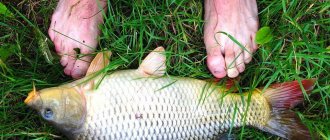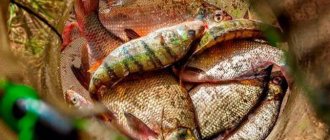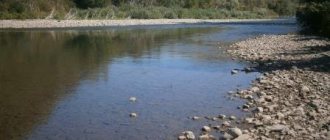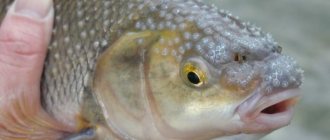Squeak is not a name, but rather the nickname of a small striped fish that lives in silted, overgrown, swampy rivers and lakes, planters, ditches and holes. Of course, this fish has a name – loach. Like crucian carp, the squeaker is probably familiar to almost everyone, and there are few people who will shrug their shoulders in bewilderment at the mention of this name.
And yet, let me introduce: a loach. An elegant small head with dark beady eyes and five pairs of antennae (two pairs each on the upper and lower jaws, 1 pair in the corners of the mouth), a long cylindrical body, three longitudinal dark stripes on the side - agree, it is difficult to confuse him with anyone .
It’s not for nothing that they call him a squeaker: a captured loach, squirming and trying to escape, emits a desperate squeak. Of course, he has no vocal cords, he squeaks... how can I say this... in general, the sound owes its origin to the exit of air through the anus. This is how the nickname stuck to the fish - squeak, gudgeon, so gudgeon and gudgeon are “two big differences.”
It’s very difficult to hold a loach in your hands - it seeps out, flows out even through tightly clenched fingers and leaves - if you don’t put a bucket or bag in time - into the wild. This fish is mistakenly considered naked; in fact, it has scales, only very small ones.
Loaches can “predict the weather”: before a thunderstorm they often rise to the surface: they rush in shallow water, stirring up the water - this means prolonged bad weather. It is not for nothing that in Germany the squeaker is called Wetterfisch (Wetter - weather, Fisch - fish, barometer fish). Of course, the loach does not have the gift of clairvoyance; simply by receptors located in the skin, he acutely senses changes in atmospheric pressure.
Another interesting point: in the process of breathing in a fish, not only the gills are involved, but also... the intestines! More precisely, its posterior section, densely intertwined with blood vessels, does not take part in the digestion of food. The fish rises to the surface, swallows air bubbles and “rolls” them through the intestines. The air gives up its oxygen, saturating the blood in the capillaries with it.
Evolution “gave” this wonderful adaptation to the loach for a reason, thanks to an additional method of breathing, but it can tolerate not only a deficiency, but also an almost complete absence of life-giving gas in the water and survives where even crucian carp cannot survive!
If the reservoir is dry, the fish fall into a kind of summer hibernation, burying themselves in wet silt; can live for quite a long time in puddles of liquid mud left in the place of a pond or ditch that dried up in summer. I once had the opportunity to rescue two three-liter jars of small (up to 5 cm) bindweed from a small mud puddle with an area of no more than 1 m2 - the puddle was simply teeming with them. Moreover, there was about 1.5 cm of water in the hole, the rest was taken up by dirt.
“I caught a huge loach - it barely fit into the frying pan.” I do not know. The heaviest thing you can catch here weighs 100 grams and 25 centimeters in length. Well, sometimes a little more than 30cm. And that's it, the limit.
The lazy loach does not like to travel, unless the flood takes him somewhere far from home. Spawns in the spring, in April-May, mainly during floods, so that the water carries the offspring away from the habitats of the parents. This small fish has fairly large caviar – almost 2mm in diameter. The larvae also develop additional respiratory organs: a powerful network of blood vessels, first on the surface of the yolk sac, then in the pectoral fins and temporary thread-like structures called external gills.
You can catch loach almost all day long, but it still catches better in the morning and evening hours. This fish is not particularly careful, so it allows you to get close to it, and there is no need for long casts. A light fly rod 4-5m long is suitable. The float is relatively light, with a load capacity of about 0.5-1g. Small hooks No. 13-14 (international).
The best bait for the loach is bloodworms; it is its main natural food. But this fish also responds well to pieces of worms, small maggots, and caddis flies. It is advisable to load the bait so that the bait lightly touches the bottom, or is 1-2cm from the bottom. Often found mixed with crucian carp. As a live bait, the loach has been highly appreciated by fishermen - in many regions it is the No. 1 bait fish.
By the way, a cute striped fish with soft touching antennae can be safely planted in an aquarium - the loach will not offend its pampered decorative inhabitants.
lovimvse.ru
Note on catching loaches
If a fish lives in an aquarium or some other container, it begins to get very worried, tries to get out countless times within a minute, and does not accept any food. Fishermen say that then it’s not worth going fishing, no fish will bite.
If the loach is actively feeding and behaving normally, then you can go fishing.
Catching loaches with a float rod
To catch a loach on a float rod, use a small float and a thin line. The hooks are tied small, the sinkers are adjusted so that the bait almost lies on the bottom, and the line sags very little.
The loach is found where there may be solid hooks, and the loach itself, greedily and confidently grabbing the bait, will quickly break free.
The hook should not be done right away. Although the loach almost never gets off the hook, you need to wait for a few exercises with the float: it will tremble a little, go under the water, and jump left and right.
It is better to catch loaches at sunset before nightfall. A worm is suitable as a bait; there have been cases when a loach grabbed an empty hook.
It is almost impossible to hold the loach, how slippery it is, and getting it onto a hook as bait is also a problem. The loach is readily taken by predatory fish, such as pike. Read also: catching pike with a girder.
After catching a loach, you need to place it in the water. This fish is very tenacious and can be preserved for a long time for various purposes.
Loach meat can be eaten in any form. It is very tender, tasty, similar to tench meat, and also does not have small bones.
Catching loaches in winter
When catching loaches in winter, you must first clear the area of vegetation and silt.
Catching a loach with a basket
It would be more correct if you catch loaches in spring or summer. There is an interesting method called “trampling loaches.” It consists of placing a basket in the center, overgrown with vegetation. The fish are driven out of their shelter in the mud and driven into a basket, that is, they are trampled down in a peculiar way.
People respect the loach for its endurance and overcoming life's adversities; it is not without reason that it has long been included in Russian folklore through proverbs and sayings.
Loach
The loach is a very small fish that lives both in rivers and in clean ponds and lakes. The loach is not of great value, but in the winter and spring season this fish becomes the number one catch. Experienced fishermen claim that loach is very tasty if cooked correctly.
Loaches are caught en masse and in large quantities, the most important thing is to choose the right tackle and bait. Since it’s spring outside our window, we’ll talk to you about how to catch loach in the warm season, and leave the winter season for later, since this is a completely different topic for conversation. And so let’s talk in more detail about the loach as a separate species.
And so the loach is a small fish reaching a small size and weighing about eighty hundred grams. The loach has no scales; it has dense skin with mucus; on the sides of the gill covers there are small needles containing an irritating secretion.
If you prick yourself with such a thorn, you can get a very painful injection, the essence is the same as with the scorpionfish. The loach is a schooling fish; this individual gathers in a large school of about twenty pieces and feeds on the entire large school. In our reservoirs, the loach is replaced by other fish, and very often the loach becomes a victim of predators.
But fortunately, the loach has a very good coloring, which camouflages it under the bottom and individual objects. Having talked about the external structure, let's move on to the loach's habits and behavior on the river and pond.
On a pond, a loach behaves differently than on a river. This is primarily due to the lack of flow. Since there is no current in the pond, the fish do not expend as much energy. On the pond, the loach lives mainly at great depths, where it waits out frosts or, conversely, hot weather.
The loach is a fish whose body temperature is constantly low and in order to maintain it at normal levels, this fish is forced to be at great depths. loach feeds on the bottom; it descends to great depths, where it sucks up silt with its mouth and filters it, after which it spits out unnecessary substances, and leaves behind the larvae of bloodworms or other invertebrates.
On a pond, the loach lives not only at depth. But also in shallow water areas. During the day, when the water begins to warm up, the loach comes closer to the shore and comes out onto the spits. In such places he feeds.
The loach races are unevenly concentrated throughout the reservoir and finding a large concentration of fish in one place is simply unrealistic, and if you want to find so many loaches, then expect the spawning period, which begins at the end of April and lasts about a week. In the morning, the loach is at a decent depth and has a state like torpor.
During the period of water warming, the loach does not rise in the water column, but moves to local areas. Local areas include thickets of reeds and small patches overgrown with grass. Here the loach feels comfortable. Towards evening, the loach leaves local areas and rushes back to the depths. This is what concerns the behavior pattern on a pond or lake.
In the river, the loach behaves differently than in the pond. Here the current turns on, and this factor also determines the constant activity of the loach. The current maintains a special thermal climate for this fish and therefore it stays here constantly. The loach rarely moves from place to place; it mainly stays in the current, where it feeds.
The shallow depth does not matter; what is important is that the current carries a lot of caddisflies and beneficial organisms that are of great nutritional value. In the morning, the loach is in the pools, but closer to lunch it comes out onto the current; also on the river, the loach can be found on extensive stretches and rifts.
If on a pond the loach's main food is bloodworms, then on the river it is caddisfly plus bloodworms, which is precisely why the river loach is stronger and slightly larger. On the river, the loach is tied to a certain place and here it hides from predators better than on the pond, since there are extensive holes and dumps, plus a lot of snags where you can camouflage well.
If you compare a pond and a river, you will see that the activity on the river is much better, and, therefore, fishing on the river is more dynamic. For a novice fisherman, it is best loaches
The correct choice of place depends on how well you have learned the habits of the loach; if the angler knows the habits, then it will not be difficult to determine the place. Having talked about habits and behavior, I propose moving on to the choice of tackle and bait.
Choosing gear for catching river loach
To catch loaches, it is best to choose a float rod without rings, namely with a blind rig. This gear is very light, and in small river conditions it is very suitable. The length of the fishing rod depends on the width of the river and the fishing area. Basically, more than four meters of gear is not required.
The fishing line that will be used when catching loach will need to be quite thin, namely with a diameter of 0.12 millimeters, this thickness is quite enough to fight such a small fish, it is more important to choose the right hook and float size. The size of the float is almost the most important and decisive factor when catching loach.
The float should not exceed the length of the match, otherwise the tackle will not be so sensitive, but will be a little rough. Be sure to include a leash made of thin fishing line with a diameter of 0.1 millimeter in the equipment. The swivel should not be included in the equipment, as it makes it heavier, and the locking unit can be closed with a small pellet.
We make the load from two pellets, and so that the distance between the pellets is minimal. Let's return to the float. It is better to choose a thin float with a bright antenna, one that will clearly show the bite on the rise.
Be sure to take several floats with you in reserve, breakages still happen and it is better to protect yourself from unwanted losses. Let's go back to the hook, you will need a hook made of thin wire and very sharp. The hook is selected not for the fish, but for the bait, in our case it is a bloodworm.
Fishing tactics and bait
When we came to the reservoir, the first thing we did was choose a place. After the place has been chosen and the most catchable point has been determined, we begin to lay out the gear and mix the bait. Bait is the basis of all fishing, and when catching loaches, bait works real miracles.
The same bait is suitable for loach as for catching roach, but it is advisable to add more maggots and bloodworms to the bait itself, depending on what we are fishing for. I usually catch loaches with bloodworms. We also add more soil to the bait so that it turns out dark, the loach loves this color, and we begin to feed the point.
You should throw the bait upstream, since all the fishing will take place on the current, you can’t go wrong with feeding. After feeding, we pause, usually about five minutes, and start fishing. The bait and tackle should be thrown to the exact feeding point, only then will there be a catching effect.
The loach is concentrated completely in the lower layer, the descent is controlled precisely by the distance from the bottom to the float, it turns out that the nozzle goes above the bottom.
As you can see, there is nothing difficult in catching a loach, the main thing is to get to know its habits and understand when it is caught. It is also important not to make a mistake with the choice of gear and the selection of components; do not forget that bait also plays a very important role and cannot be relegated to the background.
Be the first to vote Loading…
Source: https://russian-fishing.net/vyun/
Method of catching loach fish
The loach is taken with any bait; in a very stormy bite it is enough even for a bare hook. At sunset the bite is always more active. At night, he also does not sleep and pecks. The loach has a special bite: when the float floats with the current, it is at first slightly submerged, as if it is catching on the bottom, but then it abruptly goes under the water and here you have to not yawn. You need to hook after several such drownings. The loach’s appetite, frankly speaking, is excellent; as I already said, it grabs greedily and there are almost no empty bites.
Instead of a hook, they tie a needle, not behind the ear, but in the middle, and attach a worm or bloodworm. When you hook a loach, the needle becomes straight across and you can’t get off such a tackle. Previously, wicker baskets lowered into an ice hole were used as artificial traps; today they are successfully replaced by various network traps: - Muzzles, tops, hems.
Briefly about the loach.
The body of the loach is elongated, slightly compressed from the sides, its height is almost the same throughout, and its scales are small. The head is small, slightly directed downwards. The loach has a lower mouth, around which there are 5 pairs of antennae. The eyes are small, yellow, located near the forehead.
The color of a loach largely depends on its habitat. Basically it is yellow or gray-yellow with a hint of brown. On the side, from the eyes to the tail, there is a dark stripe at the top and bottom of which thin black stripes run parallel.
The loach is very widespread. The only thing he doesn’t like is fast mountain rivers. The loach prefers swampy streams, lakes, ponds, creeks and bays of large rivers. It stays at the bottom and likes to burrow into the mud. During the day, the loach hides under snags and in the grass, and comes out in search of food at dusk. Loach is a fish that does not require oxygen. In this understanding, he is tenacious even of crucian carp. Can breathe through gills, skin surface and intestines. When the reservoir dries out, it buries itself in the silt and can only emerge from it after rains.
Winter fishing for loach
In winter, fish in reservoirs do not have enough oxygen and fishermen go out fishing to help supply it to the reservoir. How? It’s simple, each fisherman drills more than one hole during one fishing trip, and taking into account how many fishermen go out on the ice, the figure turns out to be quite impressive. So the fisherman not only catches fish, but also contributes to its survival in winter by drilling holes to enrich the water with oxygen. In winter and summer, loaches are caught using specially made traps.
In our language they are now called muzzles: they are a box woven from wire or wicker with a bottom that opens at the bottom.
And the neck should fall inside the box so that the fish, when leaving it, bumps into the walls. You can also cover the entrance with a tarpaulin, and insert a tube into it through which the loach could get there. This method of fishing gives good results and a fairly large catch.
In summer, such a muzzle is simply thrown into the right place, and in winter special holes are made. The hole is widened with an ice pick, having previously been drilled with a drill, then it is covered with straw or twigs so that it does not freeze. Then we will have to wait two or three days for the loaches to gather near this place and begin to enter our face. The loach, out of necessity, will enter the trap to grab air, but will no longer be able to leave due to the structure of the trap. Thus, by checking the muzzle every day, you can simply collect a rich catch. The taste of loach fish is not bad and it can be prepared in different ways. Boil or fry the fish soup, you can dry it and then drink it with beer instead of seeds, which is also good.
At the end of it all, we need to remember that the loach fish fed entire families in the recent past.
Due to its vitality and great fertility, there were very large quantities of it in rivers and streams, in many ponds. It easily coexisted with other types of fish in the same territory and was good food for predatory fish.
The fishermen were happy to catch her, until for some reason she disappeared somewhere. Nowadays, loaches are found, but much less frequently than in the recent past.
pescare.ru
Catching loach with traps in summer and winter
The loach is not particularly popular among many fishermen. This is due to its not very pleasant snake-like appearance (resembles an eel) and the places where this fish prefers to live (silted lakes, bolts, creeks with dense vegetation).
Nevertheless, this is a very tasty and interesting fish, and its catch is completely justified. This fish causes enormous damage to other species of fish by eating the eggs they lay, sometimes the loach can thus devastate entire bodies of water. Therefore, catching loaches in any season is necessary.
Most often, the loach can be found in a reservoir with a silted bottom. In length, this fish can reach 30-35 cm, has a serpentine body shape, the ventral and dorsal fins are moved back. The caudal fin has a rounded, convex blade. The body of the loach is covered with black or light brown spots, and there may also be light and dark stripes. The diet of this fish includes a wide variety of food, insect larvae, earthworms, eggs of various types of fish and small shellfish.
The same insect larvae, worms and shellfish meat can be used as bait for catching loaches. Peak loach activity occurs at night. You can catch this fish with a float rod, just like everyone’s favorite crucian carp from the bottom. The tackle is equipped with a fishing line of 0.14-0.17 mm, the color of the fishing line must match the color of the bottom or water of the given reservoir.
In addition, when catching loaches in the summer, they also use traps, the so-called “kosh”, which are woven from willow twigs. You can catch this fish with a “mouth” or, in other words, a “top”. Such traps are usually woven from wire or silk thread. They are installed in small creeks, creeks, and channels between reservoirs. If the place is chosen well, then with one such trap you can catch several kilograms of loach per night.
Now let's talk about winter loach fishing. And although few fishermen engage in such fishing, it is very interesting, and the meat of the loach is tasty, which means it is well worth doing it. However, trying to catch a loach with a regular winter fishing rod from the ice is not worth it; this is an almost useless activity, unlike summer fishing. Winter loach fishing is carried out using traps and this is the only way to count on a good catch. With one trap in winter it is quite possible to catch several dozen specimens of this fish in one fishing trip.
Winter traps are different from summer loach traps. Making such a trap is not at all difficult. A rim from a sieve, which every housewife has, is quite suitable for this; you can also take an unnecessary basket, an old box or box. That is, a container that has hard sides.
A bottom is made of tarpaulin for the future trap, in which a hole is made in the middle. A piece of hose or tube with a diameter slightly larger than the diameter of the loach’s body is threaded into this bottom. It should also be taken into account that the tarpaulin should be slightly raised, so that there is a distance of about 5 centimeters from the edge of the sieve to the tube. Our loach trap is almost ready. In order to have a good catch of loach, you must first drill a small hole. Such a hole is needed in order to collect as many fish as possible at the fishing site, which tend to the oxygen-rich place formed as a result of the appearance of the hole.
First, you need to make the size of the hole smaller in diameter than the size of the trap itself. As a rule, such an ice hole is covered from above with tree branches or dry grass; it is possible to use tree bark and snow. This is done to avoid freezing of the hole.
Next, winter loach fishing enters a waiting phase. This is done so that as much loach as possible accumulates in the hole area and it is better to wait 2-3 days. It is easy to determine that the loach is interested in the “oxygen bait”. Foam appears on the surface of the water in the ice hole. This is the main sign that there are a lot of fish in this place on the bottom.
If the reservoir is small, then you can usually determine the presence of a loach by the squeak that this fish makes when swallowing air. The most interesting thing is that during the process of respiration, the main part of oxygen enters the loach’s body through the skin and only a smaller part through the gills.
Having determined that a large number of loaches are concentrated at the bottom under the ice, the hole, as a rule, expands. When the hole reaches the desired diameter and fits the trap, it must be installed correctly. Experienced fishermen recommend setting the trap so that it is completely out of the water. Otherwise, the loach will not stay in the trap for long and will soon leave it. To make loach fishing successful, it is recommended to cover the hole again with dry hay, branches or spruce branches.
Catching loaches in winter using the traps described above is the main type of catch during this period. As for the gastronomic qualities of eel, they are worthy of the highest praise. Loach can be fried in a frying pan, baked over coals, or stewed. Especially the meat of this fish, like eel, is delicious when smoked. And the loach has significantly fewer bones than the same crucian carp.
In addition, such a wonderful fish as loach, in addition to tasty and nutritious meat, has a very useful property for fishermen. Since ancient times, people have been able to accurately predict the weather based on the behavior of loaches.
If the loach behaves calmly, this means that in the near future the weather will be good and stable. If the loach begins to rush and circle near the very surface of the water, worsening weather with heavy precipitation is expected. This means that you can safely go fishing for perch or pike, because the bite of these fish in bad weather, on the contrary, becomes more active.
Among other things, loach is an excellent bait. Moreover, loaches are distinguished by their vitality and remain mobile for a long time, even when on a hook as bait, which means that it is always beneficial to have such live bait with you.
However, in this case the t0 of water must be taken into account. If temperature changes occur, the loach begins to behave strangely by fish standards, and the predator you are hunting for can be very alarmed by this, which means that the loach is not a suitable choice as a live bait during such periods.
A good catch of loach in winter largely depends on the correct location and installation of the trap. If everything is done correctly, then you can catch several dozen, and sometimes hundreds of individuals with one trap.
fishers.spb.ru
Appearance Features
The loach belongs to the carp family and is a freshwater fish. It grows in length from 15 to 18 cm, but there are specimens up to 30 cm or more in size. It has an elongated body, covered with very small scales, but which can be seen with the naked eye. The caudal fin has a rounded shape, and 10-12 antennae can be seen around the mouth. There is an infraorbital, non-functional spine located in the thickness of the skin. Males can be distinguished by an elongated and somewhat thickened second ray of the pectoral fin. On the left and right of the dorsal fin, there is a barely noticeable thickening formed by adipose tissue. If you have never seen this fish before, it can easily be confused with an eel or a snake.
Therefore, the loach received such a name, because of its appearance and ability to wriggle. It is possible that these factors had a direct impact on its popularity among fishermen. It is little used in food, and fishermen go out for any fish, but not for loaches.
All fins, like the rear one, have rounded, very neat shapes. The loach has both pectoral and pelvic fins, which are located at some distance from the pectoral fins. The scales of the loach are almost invisible because they are covered with a layer of mucus. On the back of an adult loach you can see black dots located on a yellow-brown surface. The belly of a loach can have different shades, depending on living conditions: it can have either a reddish or yellow color. Small, black spots can also be seen on the brown fins. The loach has small, yellow eyes.
Symmetrically, along the sides there are 3 black stripes, the middle of which is slightly longer than the other 2. Depending on the living conditions, the full color of the loach may change: if you take a loach from a river with clean running water, then the loach will have lighter colors, and if you catch this fish in a pond with a muddy bottom and not so clear water, then the loach will have shade much darker.
As mentioned above, individual specimens can reach a length of about 30 cm, and the thickness of such a fish can be equal to the thickness of an adult’s thumb.
Loach
The common loach, despite its peculiar appearance, belongs to the order Cyprinidae and the large family of loaches, numbering 117 species. Most species live within Eurasia and North Africa.
The common loach lives in the European part of Eurasia in the basin of the North and Baltic seas. The fish has an elongated body covered with small scales. Usually the length of the fish is just over 20 cm, but sometimes loaches grow up to 35 cm.
The color on the back is brown, brown, the belly is whitish-yellow. On the sides along the entire body there is a continuous wide stripe, bordered by two more thin stripes, the lower one ending at the anal fin. The caudal fin is rounded, all fins have dark spots.
The mouth is semi-inferior, rounded, there are 10 antennae on the head: 4 on the upper jaw, 4 on the lower jaw, 2 in the corners of the mouth.
The name "loach" is often applied to other species of fish. In Siberia, for example, loaches are called loaches, as well as baleen or common loaches (not to be confused with fish of the salmon family), which also belong to the loach family, but are quite different in appearance. Siberian char, as a subspecies of common char, occupies a range from the Urals to Sakhalin, its size is limited to 16-18 cm.
Loaches often live in low-flowing reservoirs with muddy bottoms and swamps. In many cases, comfortable living conditions such as clean, running, oxygen-enriched water are even less important to him than to crucian carp.
Loaches are able to breathe not only with the help of gills, but also through the skin and through the digestive system, swallowing air through the mouth. An interesting feature of loaches is their ability to respond to changes in atmospheric pressure.
When lowering, the fish behave restlessly and often surface, gasping for air. If the reservoir dries out, the loaches burrow into the silt and hibernate.
Some researchers note that loaches, like eels, are able to move on land on rainy days or during morning dew. In any case, these fish can stay out of water for a long time. The main food is benthic animals, but also eats plant matter and detritus.
It has no commercial or economic significance; fishermen use it as bait when catching predators, especially eels. Loach meat is quite tasty and is eaten.
In some cases, it is a harmful animal; loaches actively destroy the eggs of other fish species, while being very voracious.
Fishing methods
Various wicker traps are traditionally used to catch loaches. For amateur fishing, the simplest float and bottom gear, including “half-bottoms,” are often used. The most exciting fishing is using float gear.
The sizes of rods and types of equipment are used in relation to local conditions: fishing takes place in small swampy reservoirs or shallow streams. Loaches are not shy fish, and therefore you can use fairly coarse equipment.
Often the loach, along with the ruffe and gudgeon, is the first trophy of young fishermen. When fishing in flowing waters, it is possible to use fishing rods with “running” equipment. It has been noticed that loaches respond well to baits that drag along the bottom, even in stagnant bodies of water.
Often, experienced fishermen slowly drag the rig with a worm on the hook along the “wall” of aquatic vegetation, encouraging the loaches to bite.
Lures
Loaches respond well to various baits of animal origin. The most popular are various earthworms, as well as maggots, bark beetle larvae, bloodworms, caddis flies, etc. Researchers believe that breeding loaches in reservoirs close to housing reduces the number of blood-sucking insects in the area.
Fishing places and habitat
Loaches are common in Europe: from France to the Urals. There are no loaches in the Arctic Ocean, Great Britain, Scandinavia, as well as on the Iberian Peninsula, Italy, and Greece. In European Russia, taking into account the aforementioned Arctic Ocean basin, there are no loaches in the Caucasus and Crimea. Beyond the Urals there is none at all.
Spawning
Spawning takes place in spring and summer, depending on the region. In flowing water bodies, despite the sedentary lifestyle, the spawner can travel far from its habitat. Females spawn eggs among algae. Young loaches, while in the larval stage of development, have external gills, which are reduced after about a month of life.
Source: https://eklev.ru/ryby/presnovodnye/vyun.html
Habitat
Most of the loach can be observed in the reservoirs of Central and East Asia. As for the European part, it is not so rich in this interesting fish. Some numbers of loaches were noticed in eastern France, as well as in the reservoirs of Yekaterinburg and the eastern Urals.
The fact that it moved to these areas indicates that the ecosystem began to be disrupted, as a result of which part of the swamps, where it is the largest representative of the ichthyofauna, dried out. Quite a lot of this fish is found in the muddy reservoirs of the Western Urals, which give rise to the largest rivers of the Asian part of Russia. Most likely, this is due to its spread closer to Asian regions.
In the Leningrad region you can hardly find loach, and only the Kronstadt Bay and Peypus can boast of the presence of this fish.
The loach prefers swampy areas and all kinds of ditches with a large amount of silt. There is quite a lot of it in the swamps of Polesie, where its fishing is widespread. It can be found in large quantities in the Kuban, but in the Crimea and the Caucasus it can hardly be found.
Tips from experienced fishermen for catching loach
Catching loach, despite its not entirely attractive appearance, is quite an interesting and exciting activity.
The loach is distinguished by its taste and amazing vitality even after being removed from the water.
The latter feature helps this representative of the ichthyofauna reproduce in small water areas.
Appearance Features
The loach is a representative of freshwater fish from the order Cyprinidae.
- The standard length of an adult is from 15 to 18 cm, but there are specimens reaching 30 cm.
- The body shape is elongated, covered with small but visible scales. In nature, individuals without scales have been seen.
- There are 10-12 antennae around the mouth, and the caudal fin is quite rounded.
- The infraorbital spine is located deep in the skin, but does not function.
A distinctive feature of males is the elongated and slightly thickened second ray of the pectoral fin. Along the sides behind the dorsal fin, this fish has a noticeable thickening formed from adipose tissue.
In terms of external features, the loach can be compared to an eel or a snake. Thanks to its appearance and ability to wriggle, the fish received such a name. It is because of these factors that the attitude towards the loach has a certain disdainful character. As a result, it is practically not used in food, and its fishing is not very popular.
The fins of the fish are distinguished by their roundness, with the abdominal fins located a little further from the pectoral fins and characterized by their small size.
If you look at the tiny scales more closely, you will notice that they are completely covered with a mucous layer. Thanks to him, the scales of the loach are practically invisible to the human eye.
The back of an adult is yellow-brown with slight black dots. The belly of the fish is sometimes found in a reddish tint, but usually has a pronounced yellow color.
The fins of the loach are brown in color with small black spots. The eyes are yellow and small. There are 3 black stripes along the sides. Interestingly, the middle stripe is much larger in size than the outer ones.
Depending on the environmental conditions, the color of the loach changes. For example, a specimen from a river with clean and running water has a lighter shade than its counterparts from dirty water areas.
In some cases, catching this fish may result in the capture of an albino. Such a representative can reach more than 30 cm in length with a usual size of 23 cm. The thickness of the fish can vary, but is comparable to the parameters of the thumb of an adult man.
Habitat
The loach’s favorite habitat is the water bodies of Central and East Asia, but the western, northern and southeastern parts of Europe are not very rich in these representatives of the ichthyofauna. Very few numbers of this fish are observed in the eastern part of France.
Recently, the loach has been spotted in small reservoirs in the city of Yekaterinburg and the eastern slope of the Urals.
Most likely, its transition to these areas is associated with the drying out of the swampy area, where the loach is found much more often than other individuals.
The western slope of the Urals, which has silty reservoirs, is distinguished by the abundance of these representatives of cyprinids. In addition, the Ural swamps are the beginning of the largest rivers in the Asian part of Russia, hence their prevalence.
In the reservoirs of the Leningrad region, the loach is a very rare guest, only near the Krondshtat Bay and Peypus there is a little more of it.
The loach's favorite habitats are marshy areas and shallow ditches. Catching it is more common in the Pinsk swamps of Polesie.
For the Kuban, this representative of the ichthyofauna is considered the most widespread, but practically does not live in the reservoirs of the Crimea and the Caucasus.
This fish has its own requirements for its habitat. This is primarily calm water with a predominantly muddy bottom. This is precisely the reason for the large number of loaches in swampy water areas with a quiet current, in calm backwaters of large rivers, secluded tributaries, ponds and lakes with a muddy bottom.
Most often, it lives in such inconspicuous pits and swamps, where it is difficult to even imagine the presence of other fish, with the exception of the picky crucian carp. An important feature of this species is its incredible vitality: it can exist for quite a long time in wet mud, at the bottom of a dry lake, ditch, or swamp.
As a rule, the main part of the life of these fish passes in mud and silt. However, due to atmospheric hypersensitivity, this representative of the ichthyofauna is called a kind of barometer: it always floats closer to the surface with the onset of unfavorable weather.
Another remarkable feature due to which the loach is called a squeaker. This applies only to those individuals that live in very dirty water bodies. Due to the possibility of filling the food canal with air, when surfacing, a weak squeaking sound comes from the anus. This feature allows it to replace breathing with gills.
There are many ways to increase your fish catch, but the most effective ones are. Below, the site editors share with you the 3 most effective ways to increase your catch:
The diet of the loach is quite varied. This includes all kinds of larvae, mollusks, bloodworms, and worms. If there is a chance to feast on the eggs of other representatives of the aquatic world, then the loach will not miss it in any case. This predilection can have a detrimental effect on the numbers of other species.
The fish gives its main preference to mosquito larvae. From numerous observations it turned out that the loach is a rather voracious freshwater inhabitant. This fish is considered a great threat for living together in a reservoir with crucian carp or carp. Of course, for predatory species the loach is of special, tasty interest.
Breeding period
The issue of spawning in loaches causes a lot of controversy: some argue that spawning begins in winter, others - with the onset of spring, and still others - in summer and winter.
Based on the observations of experienced fishermen, it turned out that it spawns in early spring, with the arrival of March. Such an ambiguous judgment about the period of loach spawning can be explained by the duration of this process, which often begins in winter.
The fertility of females is quite high: one medium-sized female can lay up to 15 thousand eggs. There is information that indicates 150 thousand eggs.
Subtleties of fishing
Loach fishing, as a rule, occurs using conventional float gear. The best option is a fishing rod with a light, sensitive float and a No. 3 or No. 4 hook.
To ensure that the fishing thread does not stand out, it is recommended to use green fishing line, which ideally camouflages itself with turbidity and mud (regardless of the habitat). Its thickness should be no more than 0.25 mm. A wide variety of baits are suitable: grasshoppers, bloodworms, bark beetle or caddis larvae.
If you take into account the advice of experienced fishermen, then the bait must be thrown in such a way that it ends up on the border with the algae. Then you can carry out the wiring, but carefully and slowly.
It is more effective to catch loaches from a boat, moving freely with the current. If the bite was missed, you should pull out the bait and start all over again.
In general, there are no particular difficulties with catching loach; it is enough to have basic knowledge of a fisherman. Fishing techniques and gear are quite simple and standard.
The loach bite is energetic regardless of the time of day. However, there is still a peak of activity - the period between sunset and the onset of complete darkness. During a bite, the movement of the float can be compared to slight trembling, while it moves slightly to the side.
It is advisable to strike after several twitches. Given the loach’s great appetite, the bait is swallowed instantly. So the possibility of fish disappearing here is practically excluded.
There is such a simple technique for loach fishing, in which an ordinary needle is tied to the fishing line not at the end, but in the middle. A worm is taken as bait and placed on the entire needle. If all the details are followed, then the fish has no chance of leaving the needle, which, when hooked, will turn across and reliably hook the loach.
Winter fishing is somewhat different from fishing in warm seasons. You will need to make your own trap for this.
A basket, sieve, box or any similar container will do. A tarpaulin is placed on the bottom, and a hole is made in the center of the trap, which should be slightly higher. The principle of a crayfish trap is used, where there is an opportunity for fish to enter, but not for exit.
To make such a hole, you can use several methods. Try installing a tube with a larger diameter than the thickness of the loach's body. It is desirable that it be several centimeters higher than the bottom, but at the same time lower than the sides of the trap.
Trap application:
- A hole is cut in the reservoir with a smaller cross-section than the diameter of the trap.
- Twigs are laid on top of it, and then the whole thing is covered with hay.
- After everything is done, you need to wait a few days. The fish, sensing the influx of oxygen, rises up and accumulates in large schools around the hole.
- After several days, when a school of loaches is already near the hole, it is necessary to expand it and lower the trap there. The sides of the trap must be higher than the water level, so the fish will not be able to get out of it.
- Having completed all the steps, the hole is again covered with twigs and hay. It turns out that the fish will come to the surface for oxygen and crawl into a trap from which there is no way to escape.
Thanks to this method, you can catch dozens of loaches with a basket.
Of course, the loach is a very peculiar fish with a good appetite.
However, despite the unusual appearance, there are many fans of loach fishing.
Considering the simple fishing methods, even a beginner will not be left without catch. Well, the special taste of the meat of this fish is so unforgettable that many consider it a delicacy.
Useful video
Video about the underwater life of the loach:
Video about catching loaches in winter:
pike-fish.ru
Nutritional Features
The loach can eat quite a variety of foods: larvae, mollusks, bloodworms, worms. It may well feed on the eggs of other fish species, which can reduce their numbers. Enjoys eating mosquito larvae.
As observations show, this representative of the underwater world is quite voracious and can cause damage to the quantitative composition of other inhabitants, such as crucian carp or carp. But this can happen if there is a lack of other food in the reservoir. If the reservoir is muddy, then the loach will find food for itself, not paying attention to the eggs of other fish species.
Features of winter fishing
How to catch loaches in winter is described by Sabaneev. For this purpose, natural or artificial traps are prepared. Previously, wicker baskets lowered into an ice hole were used as artificial traps; today, they can be successfully replaced by various net traps: muzzles, tops, and hems.
It is much more interesting to catch loach fish in winter on “pits”. Fishing is carried out in lakes formed on former river beds, the so-called oxbow lakes. This is what the process of constructing this simple hydraulic structure looks like:
- On the shore of a frozen lake we make a trench, that very “hole”. Its dimensions are as follows: length 1.5-2 meters, width and depth about sixty centimeters.
- From the hole into the reservoir we dig a channel as wide and deep as a shovel.
- We first block the hole and channel with branches.
- Throw hay, straw or dry leaves onto the branches.
- Cover everything on top with a layer of snow.
Thanks to this shelter, the water in the canal and pit does not freeze and is therefore constantly enriched with oxygen. Starved of oxygen, the fish enters the trap through the channel to breathe. Now it is enough to block the channel with a shovel inserted into it, open the hole and scoop out the fish that have entered from it with a landing net.
Effective in ditches and overgrown ponds, as well as rivers with a slow flow or swampy and without a current. It is a relative of carp-like fish.
- Its scales are so small that they are not noticeable, or even completely absent.
- The eyes are small, the gills are also barely visible, there are antennae around the mouth, they look tiny, thread-like.
- The body of the loach is elongated, usually reaching two tens of centimeters, very rarely - three.
- Males differ slightly from females in fin structure: the pectoral fin is thicker and longer than that of the female. The male has a fat pad on the sides behind the fin on his back.
Loach habitats
This fish is found almost everywhere on the mainland. It prefers to live in mud, where it feeds on river mollusks, worms and larvae.
Sometimes there are no other fish in the pond where the loach lives. This is partly explained by the fact that the loach happily eats the eggs of other inhabitants and thus destroys its population.
The loach can be a good barometer. If he is in the wild, then before a thunderstorm or heavy downpour he rises up.
Breeding period
Not many people know when the loach starts and when it stops spawning. Because of this, quite a few disputes arise. If you believe the observations of experienced fishermen, the loach spawns in the spring, at the beginning of March. The only problem is that the spawning period can be extended in time. Some individuals begin to spawn in winter. Females are quite fertile and can lay from 15 to 150 thousand eggs. Nature has ensured that this unique species of fish has fed humans for thousands of years.
Reproduction
Spawning of fish from the loach family lasts from April to June. The female has high fertility, because she can lay up to 38,000 eggs. The diameter of one egg reaches 1.9 mm and has a brown tint. A week later, the eggs hatch into 5 mm larvae, which adhere to the plants using special organs. Also in larvae, the respiratory function is performed by dense vessels in the pectoral fins.
The fry develops and grows quite quickly, because in the first year of its life it grows up to 4 cm in length; at the age of three, their length already reaches 13 cm. Loaches are capable of reproducing after reaching the age of three. When the larva is 26 days old, its external gills disappear, and upon reaching 30 cm in length, it is considered a full-fledged fish, and not a fry.
How to catch a loach
Loach can be caught both in summer and winter. In summer, it can be caught with a regular float rod. The best option is a fishing rod with a sensitive float, equipped with hooks No. 3-No. 4. It is advisable to use a green fishing line so that it does not stand out at the bottom, among the silt and underwater thickets. The thickness of the fishing line can be within 0.25mm, although you can immediately say that it is thick enough for catching loaches, so you can use a thinner fishing line. There is no need to catch particularly large specimens. You can use grasshoppers, bloodworms, bark beetle larvae or caddis flies as bait.
According to the recommendations of experts, the bait should be cast to the border of clean water and algae, and then slowly carried out. If you have a boat, it can make the task easier. With the help of a boat you can move freely with the current. If there was a bite during the retrieve, but the fish was not caught, then you can return to the starting point and repeat your actions. There shouldn’t be any special problems with catching loaches if you have at least some skills in handling a fishing rod. At the same time, you need to have skills in handling the boat, and even more so in the current.
Loaches bite vigorously no matter when fishing occurs, day or night, although they are most active between sunset and darkness. The loach bites in a specific way: the float can sink slightly and, as it were, move to the side. The hook should be made after several such twitches. The loach's appetite is quite large, so it swallows the bait instantly and completely, so that there are practically no escapes.
Instead of a hook, you can tie a needle to the main fishing line, this is how they practice catching eels. The needle is tied not behind the eye, but in the middle. The worm is placed on a needle and thrown into the tackle. During the bite, when the loach swallows the worm with the needle, a hook is made and the needle becomes across, so that the fish has no chance to escape.
The subtleties of loach fishing
Fishing for loach
has its own subtleties and is very exciting. The loach is a very interesting fish, it belongs to the loach family. The weight of a loach can reach 120 g, but on average 40 -70 g. The length of some types of loaches can reach 35 cm.
The body of this fish is almost cylindrical and slightly narrowed at the sides. Loach
has a small head on which there are 5 pairs of antennae, 2 pairs on the lower jaw, 2 pairs on the upper jaw and 1 pair at the corners of its mouth. The fish has brownish small eyes.
The fins have dark spots and a rounded shape, the lateral line is almost invisible, and has small scales that are covered with mucus. Its pharyngeal teeth, quite numerous, have hooks at the end, but are weak and arranged in one row.
Males and females have the same coloring, the color of the fish depends on the habitat, the darker the water, the darker the fish.
Loach fishing
It is carried out in many reservoirs of Europe and East Asia, such is the vast habitat of this fish. The loach loves quiet waters and is most often found in those rivers that have a calm, slow flow, as well as ponds, lakes, ditches and swamps.
This species is a typical bottom fish, unpretentious, hardy and very tenacious. The quality of water does not have a special effect on the loach; it can colonize very shallow water bodies that are completely overgrown with vegetation.
When there is a severe drought and the reservoir dries up, this fish buries itself in the mud and remains there until the drought ends.
Many fishermen believe that the loach
like an eel, it can overcome decent areas of dry shore separating reservoirs and move from one reservoir to another.
If there is not enough oxygen then the loach
can rise to the surface and swallow air with its mouth and push it through the intestines. The intestinal walls contain a large number of blood vessels that provide the loach with respiratory functions. This interesting feature explains the squeak made by the fish when it is pulled out of the water.
This fish prefers food of animal origin, primarily a variety of larvae, small mollusks, bloodworms, and worms. For loach fishing
Bloodworms and worms are the best baits. The diet of the loach also includes caviar of other types of fish; if the loach population in a reservoir is large, this can cause damage to other species of fish living in this reservoir.
The loach becomes sexually mature when it reaches two years of age. The spawning period of the loach lasts from May to June. Loach fishing
, as a rule, is fished with a float rod; the loach is also well caught with the muzzle (mouth).
The fishing rod should be equipped with a light and sensitive float, fishing line 0.17-0.20 mm, with a blue or green tint, hook No. 3-4. Catching a loach is not difficult and even interesting. This fish can bite throughout the day.
The most active biting phase occurs before sunset and lasts until darkness.
Fishing for loaches can be carried out using bloodworms and other baits of animal origin, grasshoppers, horse flies, bark beetles, caddis flies, earthworms or dung worms.
To improve the loach's bite, the bait should be placed at the very border of the algae and then reeled rather slowly. The most effective way to catch loach is from a boat, while letting the bait drift with the current.
If there is no bite during retrieving, the bait is again released with the flow.
During the bite, the float begins to tremble and then moves to the side, after which you can hook, and the loach rarely leaves the hook.
There are some interesting tricks in catching loaches, for example, catching loaches
on a needle. The fishing line is tied to the middle of the needle, and a worm is attached to it. When the fish grabs the bait, they hook it, the needle at this time becomes across and prevents the fish from leaving.
Loach fishing
It is carried out mainly in the summer, but this fish can also be caught in the winter. The loaches are caught at this time with special traps. This trap is made from a square box. The bottom of such a trap is made of burlap; it is installed in such a way that it sags by 4-5 cm.
A tube with a diameter of 50 mm or more is fixed above the hole in the center of the burlap bottom at a distance of 2.5 cm from it. The burlap is then pulled tightly so that the top of the trap is about 5 cm above the top of the tube.
this design is very similar to an inverted watering can that is located inside the box.
Such a trap is installed in an ice hole, covered with straw or grass on top, and then everything is covered with snow. The loach is attracted by the influx of fresh air and passes through the tube into the trap, where it will remain until it is removed from the hole. Usually such traps are installed in the evening and in the morning they are removed and, having collected the catch, they are lowered into the hole again.
Loach meat has an excellent taste, especially when fried, but in some reservoirs loach meat can taste like mud, but getting rid of it is quite simple; you need to place the loaches in clean water for several days.
Small loaches are often used as live bait for catching pike, perch, burbot, and catfish. Thanks to its agility and vitality, the loach is an ideal bait for catching a predator. Loach fishing attracts both amateurs and athletes. The loach, with its unpretentious way of life and tasty meat, is of interest to many fishermen.
Source: https://fishers.spb.ru/publ/info/-tonkosti-rybalki-na-vyuna











